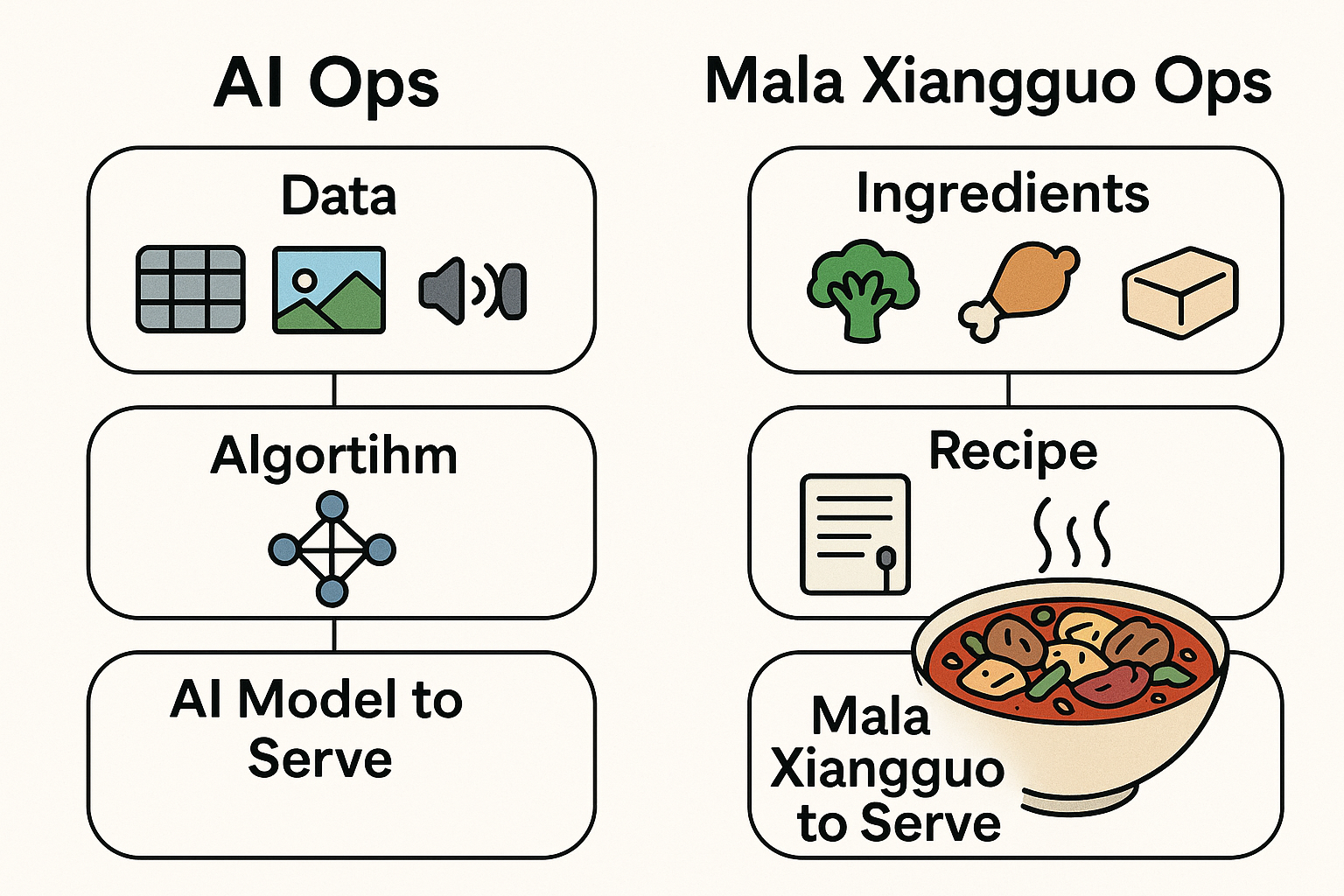Almost all quality improvement comes via simplification of design, manufacturing, layout, processes, and procedures..
Introduction
More and more mala xiangguo (or literally, numb-spicy hot pot) shops are opened in Singapore. Some Chinese restaurants that used to sell different things started to sell mala xiangguo. I did not get surprised actually, because mala xiangguo may be one of the dishes that can be easily standardized in the process, and consequently, generates better ROI than the other types of Chinese food that usually makes restaurant struggle in the middle between expanding varieties and maintaining operation cost. Different from the fast food, mala xiangguo is always cooked with the flavour that the eaters choose by themselves.
This is how I got inspired to write this post.
The Analogy: Mala Xiang Guo as an Ops System
In the world of enterprise AI, “Ops” often sounds less glamorous than algorithms or models. Yet, in practice, it’s Ops that turns intelligence into impact—the invisible force that makes AI reliable, reproducible, and scalable. Let’s make a comparative study between the Ops in AI systems and the familiar scene that anyone from China, Singapore, or elsewhere in Asia can relate to: a bustling mala xiang guo restaurant.
A mala xiang guo restaurant operates with remarkable efficiency. Customers pick their favorite ingredients—meat, tofu, mushrooms, vegetables—and hand them to the counter. Minutes later, their customized bowl arrives, perfectly balanced in flavor and texture, regardless of the ingredients chosen.
The secret is not in the chef’s improvisation, but in the Ops system: a set of standard operating procedures (SOPs) that ensure every bowl is delicious, consistent, and fast to prepare. The sauces, heat levels, and cooking steps are predefined. The process is so well-designed that complexity at the front end (customer variety) doesn’t translate into complexity at the back end (kitchen operation).
This is exactly how modern AI systems should work.

Outcome-Driven Efficiency
The mala xiang guo process focuses on outcome—the final taste—rather than every micro-step of the cooking. In AI terms, this corresponds to how MLOps, DataOps, and LLMOps focus on reducing friction in the path toward the desired outcome—accurate, deployable, and adaptive models. Ops minimizes the effort needed to achieve consistent results. A well-designed Ops framework lets teams experiment, customize, and deploy without reinventing the workflow each time—just like chefs adding new ingredients without rewriting the recipe.
Standardization Without Uniformity
As W. Edwards Deming noted,
“Standardization does not mean that we all wear the same color … Homes of infinite variety of design are built with a few types of bricks … with standard dimensions.”
Each customer’s bowl is unique, yet the process to make it is standard.
Similarly, enterprise AI systems must handle diverse data and models while
maintaining standardized pipelines—from data ingestion to deployment. When
a new data source or model variant is introduced, the pipeline shouldn’t break;
it should absorb the new element through defined interfaces and validated
steps, much like the mala xiang guo wok that harmonizes tofu, beef, and lotus
root in a single sizzling blend.
Modular and Hierarchical Design
Behind the simplicity of the dish lies a modular process: ingredients are grouped (meat, vegetables, tofu) and cooked according to their nature before combining. This modularization mirrors how AI systems categorize data types, model components, and workflows. Such design allows parallelization and decentralized orchestration, keeping the system efficient even when complexity grows. This is not just cooking—it’s pipeline engineering in disguise.
Freshness and Customization
Mala xiang guo is never precooked. Each dish is made to order—reflecting the customer’s current taste. Likewise, AI models that continuously learn from fresh data deliver relevance and responsiveness, to tackle the domain-specific problems. Ops enables this freshness: through automated retraining, monitoring, and deployment, enterprises can serve up insights as fresh as the ingredients in a wok.
Conclusion
Ops turns intelligence into an engine of value. Just as mala xiang guo transforms diverse ingredients into a harmonious meal through precise execution, AI Ops unifies data, models, and infrastructure into a consistent outcome that serves business goals. In the end, intelligence without Ops is like raw ingredients without a wok—potential without flavor.
To make custom AI truly useful in the enterprise, Ops is still all you need.
References
- W. Edwards Deming (1986). Out of the Crisis. MIT Press.
- Taiichi Ohno (1988). Toyota Production System: Beyond Large-Scale Production. Productivity Press.
- Tom Peters (1992). Liberation Management. Alfred A. Knopf.
- James P. Womack & Daniel T. Jones (1996). Lean Thinking: Banish Waste and Create Wealth in Your Corporation. Simon & Schuster.
- A Survey of AIOps for Failure Management in the Era of Large Language Models”, Lingzhe Zhang, Tong Jia, Mengxi Jia, Yifan Wu, Aiwei Liu, Yong Yang, Zhonghai Wu, Xuming Hu, Philip S. Yu, Ying Li.
Citation
Plain citation as
Zhang, Le. Ops is Still All You Need. Thinkloud. https://yueguoguo.github.io/2025/10/05/ops-is-all-you-need/, 2025.
or Bibliography-like citation
@article{yueguoguo2025opsisallyouneed,
title = “Ops is Still All You Need”,
author = “Zhang, Le”,
journal = “yueguoguo.github.io”,
year = “2025”,
month = “Oct”,
url = “https://yueguoguo.github.io/2025/10/05/ops-is-all-you-need/”
}